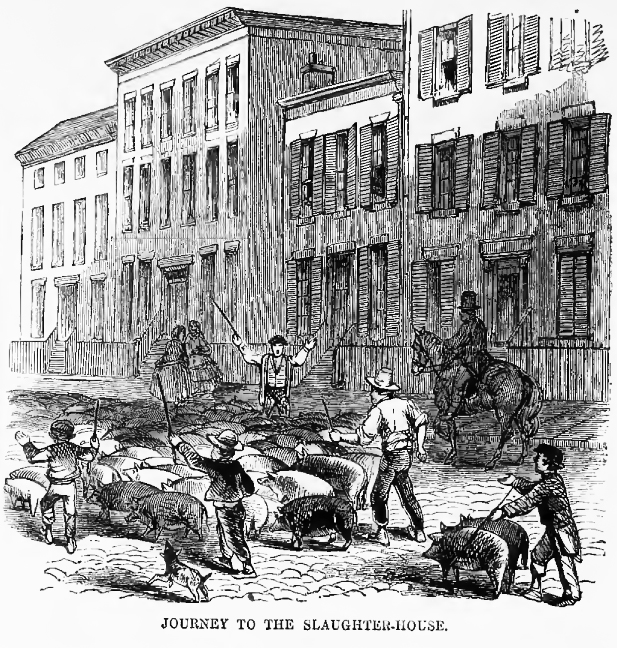Today, Cincinnati loves its flying pigs, a fantasy creature based on our heritage as a pork packing powerhouse. Few contemporary Cincinnatians can imagine the pungent reality of “Porkopolis” in the days when slurping, grunting, reeking pigs infested every yard and alley.

From Harper’s Weekly 4 February 1860 Page 72 (of the bound volume), Digitized by Internet Archive: https://archive.org/details/harpersweeklyv4bonn Image extracted from PDF by Greg Hand
The first mentions of “Porkopolis” in print appeared around 1840, but Cincinnati was already packing a lot of hog flesh well before then. By 1840, according to Charles Cist, 48 Cincinnati packing houses employed 1,200 men producing more than $3 million of packed pork. In 1860, 2,400 men slaughtered as many as 450,000 hogs each year in Cincinnati.
According to Moses King, in his 1879 Pocket-Book of Cincinnati, our city’s nickname began in England:
“Porkopolis is one of the names by which Cincinnati is known, and its origin is explained in the following manner: About 1825 George W. Jones, president of the United States branch-bank, and known as “Bank Jones,” was very enthusiastic about the fact that 25,000 to 30,000 hogs were being killed in this city every year; and in his letters to the bank’s Liverpool correspondent he never failed to mention the fact, and express his hope of Cincinnati’s future greatness as a provision-market. The correspondent, after receiving a number of these letters, had a unique pair of model hogs made of papier mache, and sent them to George W. Jones as the worthy representative of ‘Porkopolis.’”
Cincinnati’s pork production was a winter industry. Cold temperatures were necessary to chill the butchered hogs throughout the slaughtering, chopping and packing process and industrial freezers would not become economical until long after Chicago had taken on Cincinnati’s former role as “hog butcher to the world.” During the summer, a visitor to Cincinnati would have no idea why the town was called Porkopolis.
Come autumn, however, visitors found porcine evidence all around them, whether they wanted to or not. Frances “Fanny” Trollope is infamous for publishing a scathing indictment of Cincinnati in her 1832 book “Domestic Manners of the Americans”. A great deal of her bile is directed at our pigs:
“If I determined upon a walk up Main-street, the chances were five hundred to one against my reaching the shady side without brushing by a snout fresh dipping from the kennel; when we had screwed our courage to the enterprise of mounting a certain noble-looking sugar-loaf hill, that promised pure air and a fine view, we found the brook we had to cross, at its foot, red with the stream from a pig slaughterhouse while our noses, instead of meeting ‘the thyme that loves the green hill’s breast,’ were greeted by odours that I will not describe, and which I heartily hope my readers cannot imagine.”
And Fanny wrote when Cincinnati was only beginning our long run to pork-packing prominence. In 1856, another Englishwoman, Isabella Lucy Bird, came to town and had many nice things to say in her book, “The Englishwoman In America”:
“But after describing the beauty of her streets, her astonishing progress, and the splendour of her shops, I must not close this chapter without stating that the Queen City bears the less elegant name of Porkopolis; that swine, lean, gaunt, and vicious looking, riot through her streets; and that, on coming out of the most splendid stores, one stumbles over these disgusting intruders. Cincinnati is the city of pigs. As there is a railway system and a hotel system, so there is also a pig system by which this place is marked out from any other. At a particular time of year they arrive by thousands — brought in droves and steamers to the number of 500,000 — to meet their doom, when it is said that the Ohio runs red with blood.”
Few pigs were actually raised in Cincinnati. Most came from farms as far away as Columbus. Some were driven directly into town, while others arrived by train, canal boat or riverboat, but all had to be herded through the city by drovers and guttersnipes who cared not a whit for obstacles, human or otherwise. According to Harper’s Weekly:
“A drove once started on its journey is bound, at all hazards and against obstacles, to go through. What obstruction or inconvenience it may prove to vehicles in the street or the crowd of passers upon the sidewalk, is a consideration that troubles in no degree the heads of the contractor and his yelling and slashing gang of vagabonds. You may be splashed and run into, delayed and otherwise offended, upset, it may be.”
In 1860, at the height of Cincinnati’s dominance of the industry, pigs had taken over the city. Here is Nicholas Augustus Woods, Special Correspondent to The Times of London:
“They pervade the whole place—the very gutters are congested with them, and a sort of dull monotony of pigs is visible everywhere. They come against you wherever you turn, from huge, black, muddy, unsightly monsters, down to little sucklings not much bigger than kittens, on which you inadvertently tread and stumble, amid shrill squeakings almost enough to blow you off your legs, and quite enough to alarm the neighbourhood, if it had not long ago got used to every possible variation of noise in which swine can convey their thrilling protests of resentment or alarm.”
Thank heavens, indeed, that pigs cannot fly!
By 1875, the nickname, “Porkopolis,” had abandoned our town and attached itself to Chicago, which far outpaced Cincinnati in pork production after the Civil War. The name only drifted back to Cincinnati as a nostalgic sobriquet about the time the last of our stockyards and packing plants shut down or moved away.
This article was reposted with permission from Greg Hand, editor of Cincinnati Curiosities





Facebook Comments